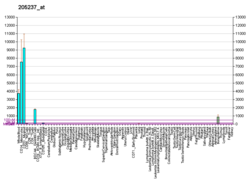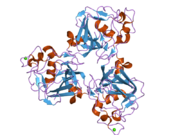Protein-coding gene in the species Homo sapiens
| FCN1 |
|---|
 |
| Available structures |
|---|
| PDB | Ortholog search: PDBe RCSB |
|---|
| List of PDB id codes |
|---|
2D39, 2JHH, 2JHI, 2JHK, 2JHL, 2JHM, 2WNP |
|
|
| Identifiers |
|---|
| Aliases | FCN1, FCNM, ficolin 1 |
|---|
| External IDs | OMIM: 601252; MGI: 1341158; HomoloGene: 1518; GeneCards: FCN1; OMA:FCN1 - orthologs |
|---|
| Gene location (Human) |
|---|
 | | Chr. | Chromosome 9 (human)[1] |
|---|
| | Band | 9q34.3 | Start | 134,903,232 bp[1] |
|---|
| End | 134,917,912 bp[1] |
|---|
|
| Gene location (Mouse) |
|---|
 | | Chr. | Chromosome 2 (mouse)[2] |
|---|
| | Band | 2|2 A3 | Start | 27,966,390 bp[2] |
|---|
| End | 27,974,897 bp[2] |
|---|
|
| RNA expression pattern |
|---|
| Bgee | | Human | Mouse (ortholog) |
|---|
| Top expressed in | - monocyte
- granulocyte
- trabecular bone
- bone marrow
- blood
- bone marrow cells
- buccal mucosa cell
- appendix
- spleen
- periodontal fiber
|
| | Top expressed in | - granulocyte
- morula
- bone marrow
- body of femur
- lumbar subsegment of spinal cord
- cochlea
- vestibular membrane of cochlear duct
- spleen
- triceps brachii muscle
- submandibular gland
|
| | More reference expression data |
|
|---|
| BioGPS |  | | More reference expression data |
|
|---|
|
| Gene ontology |
|---|
| Molecular function | - sialic acid binding
- protein binding
- G protein-coupled receptor binding
- metal ion binding
- carbohydrate binding
- pattern recognition receptor activity
- serine-type endopeptidase activity
- carbohydrate derivative binding
| | Cellular component | - extracellular region
- plasma membrane
- collagen
- extrinsic component of external side of plasma membrane
- membrane
- secretory granule lumen
- ficolin-1-rich granule lumen
- collagen-containing extracellular matrix
| | Biological process | - complement activation, lectin pathway
- complement activation
- G protein-coupled receptor signaling pathway
- recognition of apoptotic cell
- protein localization to cell surface
- cell surface pattern recognition receptor signaling pathway
- immune system process
- proteolysis
- innate immune response
- neutrophil degranulation
| | Sources:Amigo / QuickGO |
|
| Orthologs |
|---|
| Species | Human | Mouse |
|---|
| Entrez | | |
|---|
| Ensembl | | |
|---|
| UniProt | | |
|---|
| RefSeq (mRNA) | | |
|---|
| RefSeq (protein) | | |
|---|
| Location (UCSC) | Chr 9: 134.9 – 134.92 Mb | Chr 2: 27.97 – 27.97 Mb |
|---|
| PubMed search | [3] | [4] |
|---|
|
| Wikidata |
| View/Edit Human | View/Edit Mouse |
|
Ficolin-1, and also commonly termed M-ficolin is a protein that in humans is encoded by the FCN1 gene.[5][6][7]
Proteins of the ficolin family consist of a leader peptide, a short N-terminal segment, followed by a collagen-like domain, and a C-terminal fibrinogen-like domain. The name of ficolin was derived from the latter two domains. The collagen-like and the fibrinogen-like domains are also found in other proteins such as tenascins, while the former is also found in complement protein C1q and collectins, which include mannose-binding lectin and lung surfactant proteins. Ficolins selectively recognize acetylated compounds. M-ficolin encoded by FCN1 is predominantly expressed in the peripheral blood leukocytes, and has been postulated to function as a plasma protein with elastin-binding activity. Several SNPs have been described in the FCN1 gene with impact on serum concentrations of M-ficolin and the ligand binding ability. M-ficolin levels reflect disease activity and predict remission in early rheumatoid arthritis.
References
- ^ a b c GRCh38: Ensembl release 89: ENSG00000085265 – Ensembl, May 2017
- ^ a b c GRCm38: Ensembl release 89: ENSMUSG00000026835 – Ensembl, May 2017
- ^ "Human PubMed Reference:". National Center for Biotechnology Information, U.S. National Library of Medicine.
- ^ "Mouse PubMed Reference:". National Center for Biotechnology Information, U.S. National Library of Medicine.
- ^ Lu J, Tay PN, Kon OL, Reid KB (Mar 1996). "Human ficolin: cDNA cloning, demonstration of peripheral blood leucocytes as the major site of synthesis and assignment of the gene to chromosome 9". Biochem J. 313 (2): 473–8. doi:10.1042/bj3130473. PMC 1216931. PMID 8573080.
- ^ Endo Y, Sato Y, Matsushita M, Fujita T (Feb 1997). "Cloning and characterization of the human lectin P35 gene and its related gene". Genomics. 36 (3): 515–21. doi:10.1006/geno.1996.0497. PMID 8884275.
- ^ "Entrez Gene: FCN1 ficolin (collagen/fibrinogen domain containing) 1".
Further reading
- Lu J, Le Y (1999). "Ficolins and the fibrinogen-like domain". Immunobiology. 199 (2): 190–9. doi:10.1016/s0171-2985(98)80026-0. PMID 9777405.
- Ichijo H, Hellman U, Wernstedt C, et al. (1993). "Molecular cloning and characterization of ficolin, a multimeric protein with fibrinogen- and collagen-like domains". J. Biol. Chem. 268 (19): 14505–13. doi:10.1016/S0021-9258(19)85267-5. PMID 7686157.
- Matsushita M, Endo Y, Taira S, et al. (1996). "A novel human serum lectin with collagen- and fibrinogen-like domains that functions as an opsonin". J. Biol. Chem. 271 (5): 2448–54. doi:10.1074/jbc.271.5.2448. PMID 8576206.
- Harumiya S, Takeda K, Sugiura T, et al. (1997). "Characterization of ficolins as novel elastin-binding proteins and molecular cloning of human ficolin-1". J. Biochem. 120 (4): 745–51. doi:10.1093/oxfordjournals.jbchem.a021474. PMID 8947836.
- Le Y, Tan SM, Lee SH, et al. (1997). "Purification and binding properties of a human ficolin-like protein". J. Immunol. Methods. 204 (1): 43–9. doi:10.1016/S0022-1759(97)00029-X. PMID 9202708.
- Matsushita M, Endo Y, Fujita T (2000). "Cutting edge: complement-activating complex of ficolin and mannose-binding lectin-associated serine protease". J. Immunol. 164 (5): 2281–4. doi:10.4049/jimmunol.164.5.2281. PMID 10679061.
- Strausberg RL, Feingold EA, Grouse LH, et al. (2003). "Generation and initial analysis of more than 15,000 full-length human and mouse cDNA sequences". Proc. Natl. Acad. Sci. U.S.A. 99 (26): 16899–903. Bibcode:2002PNAS...9916899M. doi:10.1073/pnas.242603899. PMC 139241. PMID 12477932.
- Zeng L, Dai J, Ying K, et al. (2003). "Identification of a novel human angiopoietin-like gene expressed mainly in heart". J. Hum. Genet. 48 (3): 159–62. doi:10.1007/s100380300025. PMID 12624729.
- Gregory LA, Thielens NM, Matsushita M, et al. (2004). "The X-ray structure of human mannan-binding lectin-associated protein 19 (MAp19) and its interaction site with mannan-binding lectin and L-ficolin". J. Biol. Chem. 279 (28): 29391–7. doi:10.1074/jbc.M402687200. PMID 15117939.
- Zhang Z, Henzel WJ (2005). "Signal peptide prediction based on analysis of experimentally verified cleavage sites". Protein Sci. 13 (10): 2819–24. doi:10.1110/ps.04682504. PMC 2286551. PMID 15340161.
- Gerhard DS, Wagner L, Feingold EA, et al. (2004). "The status, quality, and expansion of the NIH full-length cDNA project: the Mammalian Gene Collection (MGC)". Genome Res. 14 (10B): 2121–7. doi:10.1101/gr.2596504. PMC 528928. PMID 15489334.
- Frederiksen PD, Thiel S, Larsen CB, Jensenius JC (2006). "M-ficolin, an innate immune defence molecule, binds patterns of acetyl groups and activates complement". Scand. J. Immunol. 62 (5): 462–73. doi:10.1111/j.1365-3083.2005.01685.x. PMID 16305643. S2CID 35639359.
- Tanio M, Kondo S, Sugio S, Kohno T (2007). "Trivalent recognition unit of innate immunity system: crystal structure of trimeric human M-ficolin fibrinogen-like domain". J. Biol. Chem. 282 (6): 3889–95. doi:10.1074/jbc.M608627200. PMID 17148457.
Arthritis Rheum. 2013 Dec;65(12):3045-50. doi: 10.1002/art.38179. M-ficolin levels reflect disease activity and predict remission in early rheumatoid arthritis. Ammitzbøll CG1, Thiel S, Jensenius JC, Ellingsen T, Hørslev-Petersen K, Hetland ML, Junker P, Krogh NS, Østergaard M, Stengaard-Pedersen K.
 | This article on a gene on human chromosome 9 is a stub. You can help Wikipedia by expanding it. |

 2d39: Trivalent Recognition Unit of Innate Immunity System; Crystal Structure of human M-ficolin Fibrinogen-like Domain
2d39: Trivalent Recognition Unit of Innate Immunity System; Crystal Structure of human M-ficolin Fibrinogen-like Domain
















